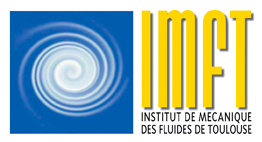Quantification de l'erreur de transposition pour les calculs CFD de transferts thermiques.
[ 30% expérimental – 30% CFD – 40% UQ + POD + post-traitements .
Abstract:
The work presented in this dissertation deals with the use of RANS CFD commercial solvers for heat transfer computations of nuclear reactor components. The validation of two codes has been previously performed on reduced scale mock-ups at smaller Reynolds number scale in experimental facilities. The objective of this work has been to verify if the accuracy of calculation of the heat transfer coefficient with CFD evolves when approaching the real reactor scale Reynolds number. Experiments and CFD computations have been conducted for this purpose. The first step has been to lay down the basics of CFD and uncertainty quantification. The latter subject provides a working environment which consolidates the validation approach, as the comparisons are given by taking into consideration the different sources of uncertainty in heat transfer simulations and experiments. An important aspect of this work has been to develop a measurement methodology to retrieve heat transfer coefficient maps for water exchanging with a heated smooth wall with reasonable uncertainty. The method that has been chosen is based on the gypsum dissolution and the heat and mass transfer analogy. The measured mass transfer coefficient has been transposed to smooth wall heat transfer coefficient by considering the roughness of the gypsum surface after dissolution and the difference of heat and mass diffusion in water. The values of the heat transfer coefficient obtained have been compared to literature for Reynolds number in the range on the well documented case of heat exchange in a rectangular channel for turbulent flow, showing good agreement. Then, two commercial softwares were tested for computations of the heat transfer coefficient by reproducing the experiments. In the rectangular channel, the boundary conditions uncertainty during the experiments were propagated through the CFD simulations with two different methods: the deterministic sampling which uses a limited number of sigma points to propagate the covariance of the inputs and Monte Carlo method which relies on the estimation of large samples of the boundary conditions with a surrogate model based on Gaussian process. These two methods have been found to yield identic results indicating that the boundary conditions uncertainty is negligible in comparison to the experimental uncertainty. Finally, the comparison between CFD and experiments has been done and combined to the experimental uncertainty to estimate the model error which has been found to decrease for increasing Reynolds numbers. The process has then been reproduced for comparisons of CFD and experiments in a 1/5th reduced scale mock-up of a steam generator inlet volume. The measurement methodology has been adapted and combined both heat and mass transfer measurements. The 2D mass transfer data has been processed with the Proper Orthogonal Decomposition and the heat transfer measurements were used to measure the transposition factor. Heat and mass transfer data showed consistent values indicating good confidence on the heat and mass transfer analogy. The heat and mass transfer measurements were then combined to proceed to the uncertainty quantification of CFD on the Reynolds number range [10^5 – 10^6]. The numerical error has been estimated with a grid convergence method (GCM) using Richardson extrapolation and was shown to be negligible. The same conclusion was drawn for the boundary conditions uncertainty which has been estimated with Monte-Carlo method. Finally, the comparison between CFD and experiments has been found to depend on the turbulence model, depend on near wall meshing and depend on software. It has also been concluded that the type of cells had an impact on simulations of the steam generator mock-up flow where tetrahedral cells yielded higher Nusselt number. The overall comparison between CFD computations and experiments finally showed the non-evolution of the model error with increasing Reynolds number.
Jury:
rapporteurs: B. Podvin [CentralSupelec] & L. Cordier [PPRIME];
membres: V. Botton [LMFA], C. Castelain [LTEN], M. Cissé [FRAMATOME], D. Saury [PPRIME]
Encadrants: C. Airiau [IMFT], N. GOREAUD [FRAMATOME], D. LoJacono [IMFT] (1ère année)
